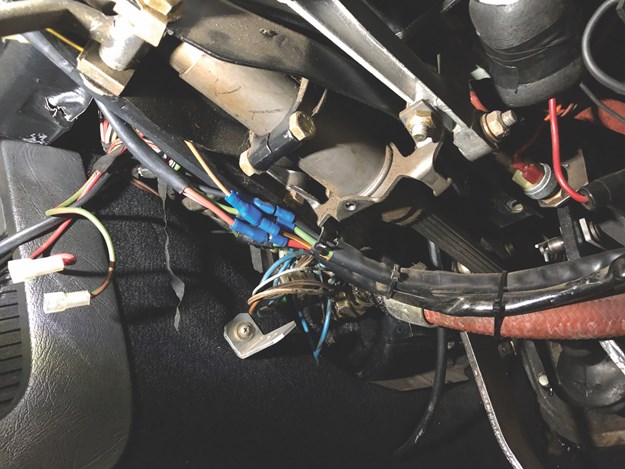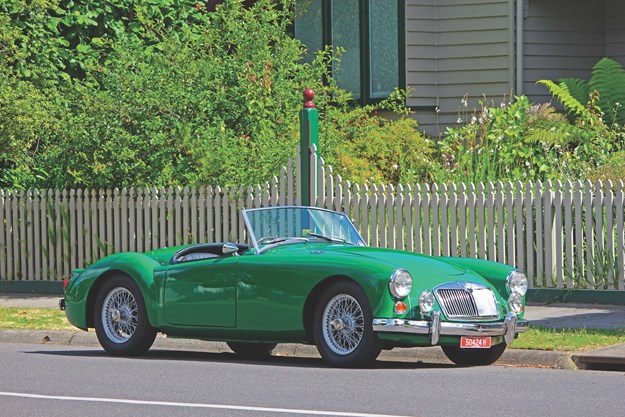Bimmer Games - Mick's Workshop
Mick is toiling away in the workshop and providing you with the car advice you need.

|
|
Jaguar XJS
|
This week, one of the string of jobs through the shed has been UC staffer Guido’s 1976 BMW, a 633CSi. It’s a very early example of the E24 series and has the Karmann build plate in the left door frame. That means it was one of a batch assembled by Karmann, before BMW took over the complete production.
Anyway, he and partner Ms M bought this thing just on a decade ago and we’ve been handling the servicing ever since. It’s done more than its fair share of long trips, including a couple of tours of Tasmania, one of them in the Targa Classic Rallye, and a run in the Bay to Birdwood.
Despite what you may think of European cars, it’s been pretty reliable and hasn’t cost a bomb to keep. New Bilstein dampers went in it a while ago, while the drivetrain has just required normal servicing. That is until the coupling-controlled fan went in Tasmania and had to be replaced. Nevertheless a quick and dodgy running repair with a bunch of cable ties got the car home.
Now it’s the turn of the very old radiator to be turfed out. Finding the right part for these things can be a bit of an art, as running changes were made early on, there are several variants, and the series underwent a major makeover in 1978 and again in 1982.
We let the owner chase the radiator through Walloth Nesch in Germany and got mixed results. It had the right plumbing points, but for some mysterious reason was a few centimetres narrower than what was in there. That meant making some not-so-subtle alterations (which may have involved a hammer) to the mounts to get everything to line up.
Oh, and there was an issue with the replacement hoses. The one we couldn’t solve was for the big lower main hose, however, we managed to find one through a speed shop on the outskirts of Melbourne.
The next challenge was the header tank, it looked okay but was leaking. Closer inspection revealed the near 50-year-old plastic had cracked and we’ve ordered a replacement, which will take four weeks.
In the meantime, we thought we’d tackle another issue, which was the ignition switch felt loose and wasn’t making proper contact. That meant the car sometimes wouldn’t start and the power windows were on the blink.
Fortunately the owner had sussed there was a loose switch and had a new one on hand for us to instal. Perfect, yes? Well, no. We started pulling apart the steering column and discovered some previous owner had indulged in some creative home wiring. So now we have to sort that out before we finish off the job. I reckon there’s no point in getting upset about these things – it’s just old-car stuff. You know that, no matter how carefully you check them out, they will pop little surprises like this and you just have to deal with it. My advice: Go make yourself a cup of tea, then come back and tackle the problem.
In the meantime, Guido can hardly complain. He paid just $7500 for this car back in 2014, so we reckon he and the missus are getting their money’s worth.

UniClutch
We’re in the process of setting up a new style of clutch in a high-horsepower Camaro for a customer, so he gets a light and more controllable pedal. The gadget we’re using is a UniClutch, designed and made in Coburg, Melbourne. A couple of young blokes are behind this and I’ve driven a car with one installed and was impressed.
It uses a dual-plate system that claims to be far more robust than standard. Have a look if you’re involved in a build.
Big Cat
I’m the (mostly) happy owner of a Jaguar XJ-S, with the 5.3lt HE V12. However, it’s getting pretty tired and so I’ve been tossing round some options: Rebuild the existing engine, go for a V8 swap (LS perhaps?) or look at converting it to a Jaguar six.
Gerald Franks
At that age the V12 should be tired and a freshen-up will be needed.
Forget the V8 and the Jaguar six, as you then start getting into a whole other list of challenges, while probably reducing the value of the Jag. Don’t make me come and find you!
It’s going to hurt financially to do a rebuild as it’s a specialist field, but it’s well worth the investment. The 5.3 is a brilliant motor. They won the European touring car championship, won Bathurst – a great thing. The big weakness with them is fuel hoses. As with the Ferraris of the period, they perish and can start a fire. Change them when you do the top end and consider swapping them over every 10 years.
With all-new fuel hoses and ignition leads, it should be bulletproof. The HE is the engine to have and it’s worth keeping it original. Even though we don’t necessarily build these things to sell, it’s nice to know it will carry on and someone else will get some benefit out of it.
Twin-cam Esky
Mick, I have a Mk1 Escort two-door with a fairly mild 1.6lt crossflow engine on board, with a manual gearbox. Like just about every other Escort owner, I’ve dreamed of owning a high-end competition version with the twin-cam in it.
To my surprise, a mate of mine in the club has a spare twin-cam and has offered it to me at what seems like fair money. Is this a big change-over and is it worth doing?
Mike Cinelli
HELL YES! There is a massive amount of knowledge out there about them, and my attitude is just go and get it and work out the details later. It will add a huge amount of performance and fun to the car, while raising its value. You really can’t go wrong with this one. It’s not a big job to put one in a Mk1, so go for it.
Hot Mustang
My Mustang notchback (1966) has a 289 V8 with auto and seems to run okay, except when we hit a hot day, particularly in traffic.
I’m guessing these old things weren’t necessarily designed for the amount of traffic we get these days.
Maybe I should go for a bigger radiator – it has a close-to-stock item that’s fairly new. What are your thoughts?
Mary Tamworth
The 289 Windsor is a brilliant engine. We spoke about one some time ago that was coming in with overheating problems. It would run okay, then get hot and you had to stop to let it cool down. It’s all to do with the cooling system. In our case, we took out the water pump, put in a better machined impeller (I prefer the blade ‘water wheel’ type) and along the way we increased the water pressure. It helps to keep the whole plot cool. While you’re at it, move the ignition coil away from the engine. All these things help.
MGA Dreams
Hi. I’m in the hunt for an MGA and am quickly finding out there are all sorts of variations out there. For example, I’m finding 1500, 1600 and even 1800 motors, in varying states of tune.
Is there any issue with a modified one – what should I be looking for?
Clem Anderson
I love a good MGA. If you’re a purist, I guess you have to go with the 1500. However, I’d be inclined to look at each car on its merits. For example, something with an 1800 and a Celica gearbox (a popular change-over) will be a very good thing to drive on the highway and much nicer than standard, without ruining the look or general feel of the car. Remember to have a good, hard look at the quality of the work and, if in doubt, get a workshop to run a critical eye over it. Good luck with it!
Wagon Hunt
Hi, Unique Cars. I have been offered a fairly rare beast, a 1966 Valiant AP6 wagon, a right-hand-drive car which I believe is Canadian-built. It’s got the whole period family car thing going on, with bench seats, the big six in the front and column-shift auto.
It seems like a nice clean car – what should I be looking for?
Anders Anderson
As with all Valiants of the period, they were prone to rust, so that’s your number one priority. When you go to look at it, take one of those soft vinyl fridge magnets (like the local plumber uses for advertising) out of the kitchen and take it with you. Place it around the bodywork (it won’t hurt the car and you don’t want a strong magnet) and see if it grips. If not, you have bog buried under the paint. You’re looking pretty much everywhere: plenum chamber, doors (particularly the bottoms), sills, rear quarters, tailgate ... check everywhere. Mechanically, they’re a Chrysler and essentially bulletproof while being easy to refresh/rebuild.
Celica Power
Hi there. I have an RA40 liftback Celica, which seems to be as reliable as you could hope for. Well, except for the battery.
I only get to use the car every couple of weeks and sometimes it’s touch and go as to whether it’s going to play.
What would you suggest? I’m guessing a battery tender, and should I upgrade to a gel or even lithium battery?
Sam Colterris
You need to put in a decent charging system, one that’s wired to the battery and can simply be unplugged when you want to go so you’re not messing around with clamps. So, when you want to go, you unplug it and off you go. As for the battery, a normal lead-acid battery is just fine. A gel is a better thing, but lead acid is fine. I wouldn’t go so far as lithium.
Unique Cars magazine Value Guides
Sell your car for free right here
Get your monthly fix of news, reviews and stories on the greatest cars and minds in the automotive world.
Subscribe


.jpg)













